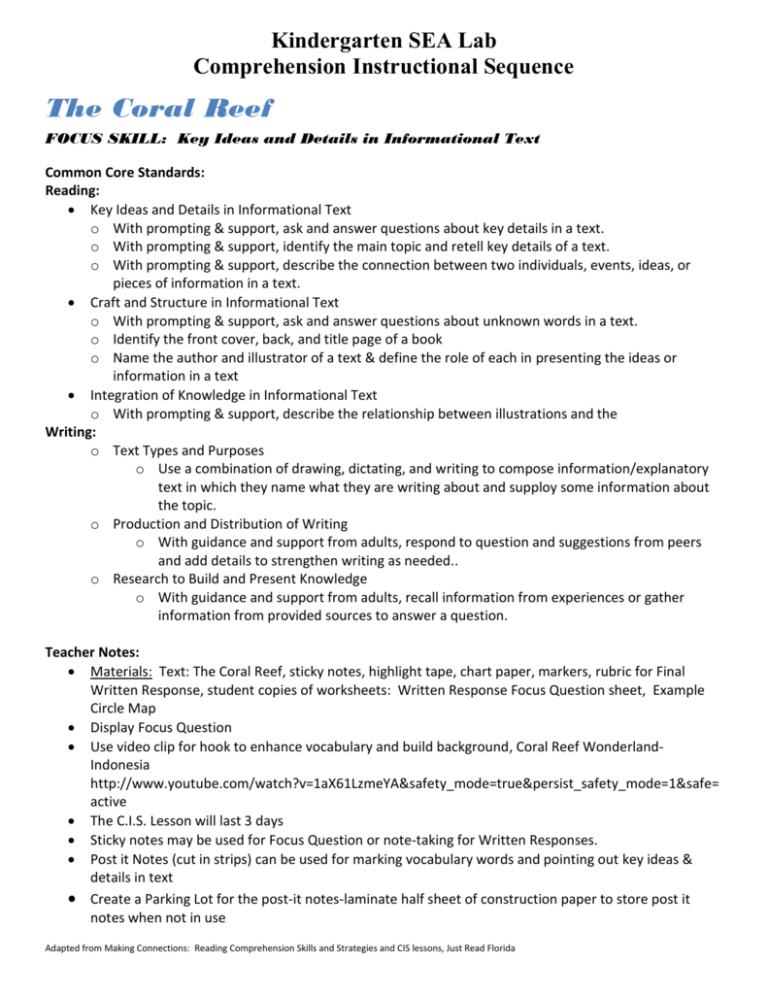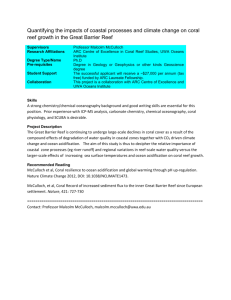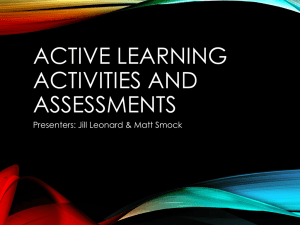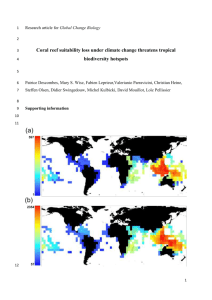Kindergarten SEA Lab - Volusia County Schools
advertisement

Kindergarten SEA Lab Comprehension Instructional Sequence The Coral Reef FOCUS SKILL: Key Ideas and Details in Informational Text Common Core Standards: Reading: Key Ideas and Details in Informational Text o With prompting & support, ask and answer questions about key details in a text. o With prompting & support, identify the main topic and retell key details of a text. o With prompting & support, describe the connection between two individuals, events, ideas, or pieces of information in a text. Craft and Structure in Informational Text o With prompting & support, ask and answer questions about unknown words in a text. o Identify the front cover, back, and title page of a book o Name the author and illustrator of a text & define the role of each in presenting the ideas or information in a text Integration of Knowledge in Informational Text o With prompting & support, describe the relationship between illustrations and the Writing: o Text Types and Purposes o Use a combination of drawing, dictating, and writing to compose information/explanatory text in which they name what they are writing about and supploy some information about the topic. o Production and Distribution of Writing o With guidance and support from adults, respond to question and suggestions from peers and add details to strengthen writing as needed.. o Research to Build and Present Knowledge o With guidance and support from adults, recall information from experiences or gather information from provided sources to answer a question. Teacher Notes: Materials: Text: The Coral Reef, sticky notes, highlight tape, chart paper, markers, rubric for Final Written Response, student copies of worksheets: Written Response Focus Question sheet, Example Circle Map Display Focus Question Use video clip for hook to enhance vocabulary and build background, Coral Reef WonderlandIndonesia http://www.youtube.com/watch?v=1aX61LzmeYA&safety_mode=true&persist_safety_mode=1&safe= active The C.I.S. Lesson will last 3 days Sticky notes may be used for Focus Question or note-taking for Written Responses. Post it Notes (cut in strips) can be used for marking vocabulary words and pointing out key ideas & details in text Create a Parking Lot for the post-it notes-laminate half sheet of construction paper to store post it notes when not in use Adapted from Making Connections: Reading Comprehension Skills and Strategies and CIS lessons, Just Read Florida Kindergarten SEA Lab Comprehension Instructional Sequence DAY ONE Opening Discussion: Explain to students that for the next three days they will be learning about life in the coral reef. Display the title page and read the title. Tell them a little about the book just as you would be telling someone about a book you read. Build Background Knowledge w/Hook: Show video clip, pausing to explain what is occurring using the actual vocabulary in the text when appropriate. Show illustrations from page 3, 7, 13 to get students excited about the coral reef they will be reading about in the book. Skill Focus: Focus skill- Identifying Key Ideas & Details Explain to students what readers do when they are identifying details (finding the important words that tell about something). A. Explain to students that details help readers’ understand a topic better by answering the questions who, what, when, where, why, or how. B. Display the key ideas & details poster. C. Tell them that authors write details about things so that readers can “see” pictures in their minds. Tell them that illustrations can also provide details to help readers picture what is happening. Text Structure/Features: Explain to students the type of book they will be reading for the next two days is informational text. A. Display and read the title. Display and read the table of contents. B. Explain to students the book has chapters so there is a table of contents that tell the titles of those chapters. Books that contain chapters will have a table of contents. C. This book also has a glossary. Show glossary page. Briefly explain the function of each. This book also tells about other books on this topic in a “Read More” section as well as Internet Sites. Predictive Writing: Have students write a brief response to the focus question located on the Predictive Written Response sheet or draw a picture. A. This can be a word, phrase, sentence or picture. Students do not have to write a complete sentence. B. Assist students having trouble with this task. C. Then share with partner. Predictive Written Response to Focus Question. What plants and animals live in and around a coral reef? Adapted from Making Connections: Reading Comprehension Skills and Strategies and CIS lessons, Just Read Florida Kindergarten SEA Lab Comprehension Instructional Sequence DAY ONE First Reading/ Vocabulary Instruction: Read aloud the book. As you read, stop at the vocabulary words and provide a friendly definition for students based on text. Place word and definition on science board and teacher marks with post-it note strips in text. pg. 2 4-5 6-7 8 10 12 14 Vocabulary Word corals blue tang clownfish green lettuce slug octopus big blue clam Danger Student-Friendly Definition Tiny animals that make up the coral reef. Baby blue tang is yellow, as it grows, changes color to blue. Orange & white, stay near green tentacles, Nemo fish. Looks like lettuce, but doesn’t taste like it. Circles on 8 long arms, help them taste & feel. Black dots are eyes to help see danger. Lives in a shell. Puffer fish puffs up to look scary. Adapted from Making Connections: Reading Comprehension Skills and Strategies and CIS lessons, Just Read Florida Kindergarten SEA Lab Comprehension Instructional Sequence DAY TWO pg. 2 4-5 6-7 8 10 12 14 Vocabulary Word corals blue tang clownfish green lettuce slug octopus big blue clam Danger Student-Friendly Definition Tiny animals that make up the coral reef. Baby blue tang is yellow, as it grows, changes color to blue. Orange & white, stay near green tentacles, Nemo fish. Looks like lettuce, but doesn’t taste like it. Circles on 8 long arms, help them taste & feel. Black dots are eyes to help see danger. Lives in a shell. Puffer fish puffs up to look scary. Review the focus skill: Display the key ideas & details poster and remind students that details help readers’ understand a topic better by answering the questions who, what, when, where, why, or how. A. Remind them that authors write details about things so that readers can “see” pictures in their minds. B. Remind students that illustrations also provide details to help readers picture what is happening. C. Sometimes illustrations show details that are not mentioned in the text. Rereading/Skill Instruction & Content Discussion Read the focus questions from the Draft Written Response. A. Point out the what and where in the questions. B. Remind students to keep the focus questions in mind because they will be writing the answers to each of them today. C. Then reread the text as students follow along in their books. D. Model marking key ideas and details in the text by placing post-it-notes under the words and phrases that provides information to answer the focus questions. Utilize the questions below to look for details to highlight that will answer the focus question. pg(s). Questions Words/Phrases to highlight with post it note all What animals live in the coral reef? highlight all but tell students when they write only to choose their top 3 they would like to include in their writing all What colors are the animals in the coral reef? Where is a coral reef? Blue, orange, black, yellow, green all In the sea, or ocean. Adapted from Making Connections: Reading Comprehension Skills and Strategies and CIS lessons, Just Read Florida Kindergarten SEA Lab Comprehension Instructional Sequence DAY THREE pg. 2 4-5 6-7 8 10 12 14 Vocabulary Word corals blue tang clownfish green lettuce slug octopus big blue clam Danger Student-Friendly Definition Tiny animals that make up the coral reef. Baby blue tang is yellow, as it grows, changes color to blue. Orange & white, stay near green tentacles, Nemo fish. Looks like lettuce, but doesn’t taste like it. Circles on 8 long arms, help them taste & feel. Black dots are eyes to help see danger. Lives in a shell. Puffer fish puffs up to look scary. Reread for Fluency: Display the vocabulary words and definitions located on the science board. Have students read this list of words chorally with the group a few times. You may then point to the words out of order to make sure that students can recognize most of them by sight. Have them monitor each other for accuracy and appropriate expression. Thinking Map: Display the Circle Map (Defining in context.) Complete the map with the students. Circle Map with the words Coral Reef in the middle. Draft Written Response/Summarizing: Explain to students that summarizing helps readers say in a few sentences what a whole text is about. Explain to students that when they summarize details, they should include the most important and only the details from the text. Have students independently work on the Draft Written Response. Students will then work with a partner to read his/her response and add detail to strengthen the writing as needed. Teacher conducts coaching and conferencing with students and partners throughout this process. Draft Written Response to Focus Question According to the text What animals live in the coral reef? What colors are the animals in a coral reef? Where is a coral reef? Use information from the text and your Circle Map to write about 2 of the animals. Day Three: Final Written Response: Have students rewrite to create a Final Written Response. The Final Written Response can be used as an assessment for student learning, aligning to Common Core Standards. Utilize a Rubric when used as an assessment. Adapted from Making Connections: Reading Comprehension Skills and Strategies and CIS lessons, Just Read Florida








